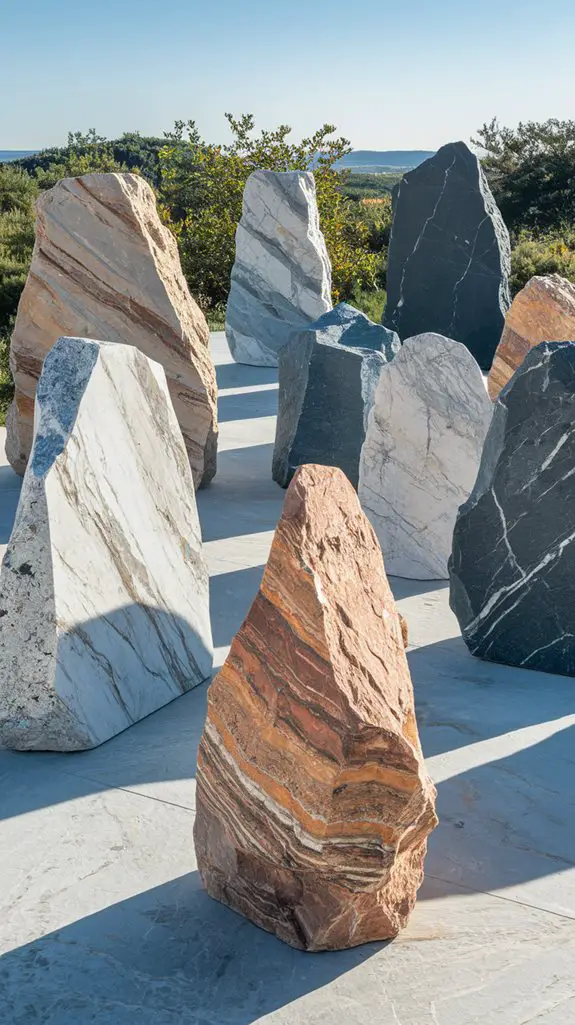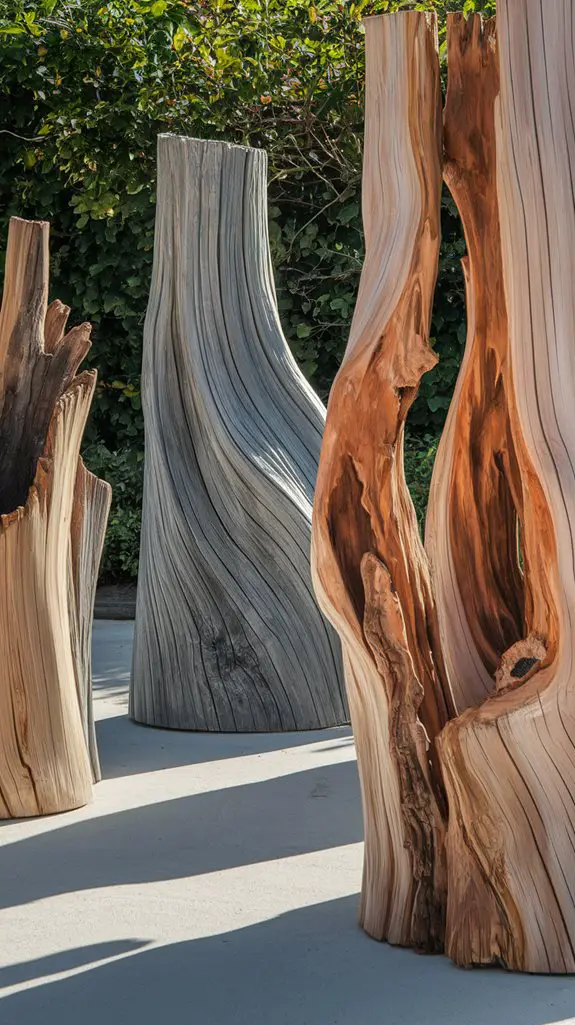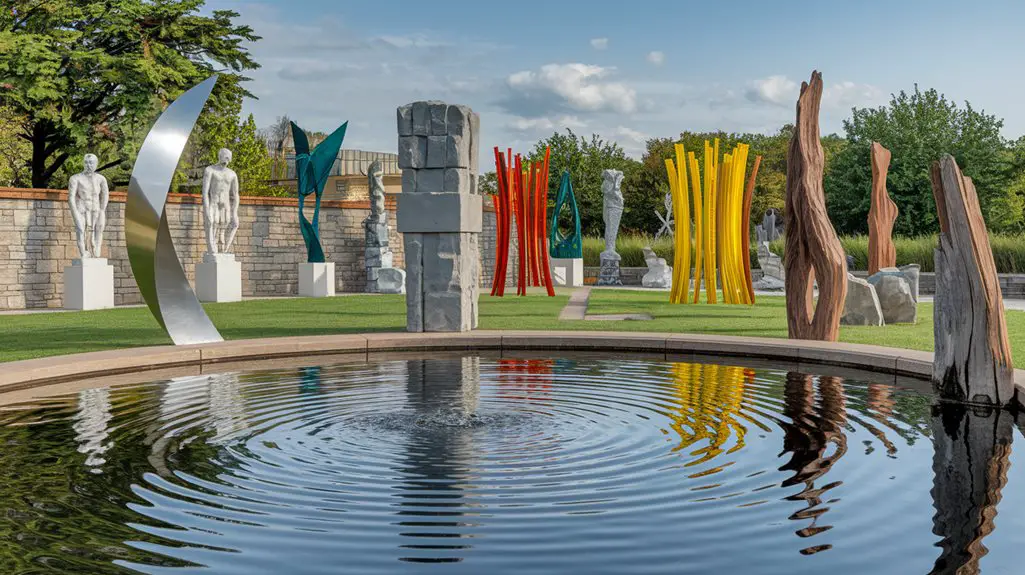While you might think outdoor art requires only weather resistance, material selection actually involves balancing durability with aesthetic expression. You’ll need to evaluate how metals like bronze reflect light differently than tempered glass, or how treated woods develop character as they age. Environmental exposure affects each material uniquely—granite maintains its integrity for decades while recycled plastics offer sustainability without sacrificing longevity. The perfect outdoor medium depends on your artistic vision and the specific challenges of your installation site.
Durable Metals: Bronze, Stainless Steel, and Corten
When selecting materials for outdoor sculptures and installations, metals represent the most enduring and versatile options available to artists.
Bronze stands out for its rich patina that deepens over time and its remarkable resistance to weathering—a quality that has preserved ancient bronzes for millennia.
Stainless steel offers exceptional corrosion resistance and a contemporary aesthetic, requiring minimal maintenance while withstanding harsh environments.
Its reflective properties can dramatically enhance artistic expression by capturing surrounding light and color.
Corten (or weathering steel) delivers a unique advantage through its self-protecting rust layer.
This controlled oxidation creates a warm, reddish-brown surface that stabilizes over time, preventing deeper corrosion while providing a striking, evolving appearance.
Unlike traditional steel, Corten doesn’t require painting or finishing, making it increasingly popular for modern outdoor installations. Artists often incorporate various art elements into their backyard designs, enhancing the overall aesthetic and inviting engagement with the space.
Weather-Resistant Stone Options for Sculptural Work

Stone’s timeless appeal in outdoor art stems from its natural durability and intrinsic connection to landscape environments. When selecting stone for outdoor sculptures, focus on dense, non-porous varieties that resist freeze-thaw damage.
Granite ranks highest for weatherability with its crystalline structure and minimal water absorption rate of 0.4%. Its compressive strength exceeds 19,000 psi, ensuring longevity in challenging climates.
Limestone offers versatile carving properties but requires sealing due to its 5-10% porosity. Choose dense varieties like Indiana limestone for best results.
Basalt provides exceptional hardness (6-7 Mohs) and volcanic character, while quartzite delivers translucent qualities with superior resistance to acid rain.
Avoid marble in severe weather zones; its calcite composition (3 Mohs) makes it vulnerable to acid precipitation and surface erosion over time.
Treated Woods and Natural Timber Selections

While stone provides exceptional longevity for outdoor sculptures, wood offers artists a renewable medium with distinct organic qualities and textural possibilities.
For outdoor applications, cypress, redwood, and cedar contain natural oils that resist decay and repel insects. These species don’t require chemical treatments for moderate durability.
For enhanced longevity, pressure-treated lumber incorporating copper azole or ACQ preservatives provides robust protection against fungal deterioration and insect infestation.
You’ll find that marine-grade plywood, treated with phenolic resins, withstands moisture exposure considerably better than standard varieties.
When selecting timber, prioritize heartwood over sapwood, as it contains higher concentrations of protective compounds.
Apply UV-resistant sealants biannually to prevent photodegradation.
Thermally modified woods offer an eco-friendly alternative, achieving dimensional stability through heat treatment rather than chemical impregnation. Additionally, opting for sustainable outdoor seating can enhance both aesthetics and environmental responsibility in garden design.
Glass and Mosaic Elements for Light Interaction
Glass and mosaic elements transform outdoor installations by manipulating light transmission, reflection, and refraction properties that change throughout the day. You’ll find these materials create dynamic visual experiences as sunlight interacts with their surfaces.
| Glass Type | Light Properties | Durability Rating |
|---|---|---|
| Tempered | High transmission | 8/10 |
| Stained | Filtered color | 7/10 |
| Laminated | UV protective | 9/10 |
| Float | Clear viewing | 6/10 |
| Cast | Textural diffusion | 9/10 |
Select thick, tempered glass (minimum 10mm) for structural integrity or laminated options for safety concerns. Mosaic tesserae should be frost-resistant with proper grouting to prevent moisture penetration. Glass-on-glass mosaics require UV-resistant adhesives preventing yellowing and delamination. Consider how seasonal light angles will affect your installation—south-facing placements maximize winter illumination while north-facing reduces summer glare.
Concrete and Cement Compounds for Longevity
Concrete and cement compounds serve as foundational materials in outdoor art installations, offering exceptional durability against environmental stressors that challenge more fragile media. When properly formulated, these mixtures withstand decades of freeze-thaw cycles, ultraviolet degradation, and precipitation without significant deterioration.
- Incorporate glass fiber reinforced concrete (GFRC) for reduced weight while maintaining structural integrity—essential for larger installations requiring less substantial foundations.
- Select polymer-modified cement compounds that enhance flexibility and reduce cracking potential during seasonal temperature fluctuations.
- Utilize integral coloring agents rather than surface treatments to guarantee color permanence despite weathering effects.
You’ll find these materials particularly cost-effective for large-scale installations where metal alternatives would prove prohibitively expensive.
Modern additives enable unprecedented workability, allowing for intricate detailing previously impossible with traditional concrete formulations.
Recycled and Upcycled Materials for Sustainable Displays
Incorporating recycled and upcycled materials into outdoor art installations not only reduces environmental impact but also introduces unique textural and visual elements unattainable with conventional media.
You’ll find that reclaimed metal, particularly aluminum and steel, withstands outdoor conditions while developing distinctive patinas over time.
Post-consumer plastics, when UV-stabilized, provide colorful, lightweight alternatives that resist water damage.
Consider repurposed glass fragments for mosaic applications—their reflective properties create dynamic interactions with sunlight.
For structural components, salvaged timber treated with non-toxic preservatives delivers rustic aesthetics and durability.
When selecting upcycled materials, evaluate their weathering characteristics and structural integrity.
Test connections between dissimilar recycled elements to prevent galvanic corrosion.
Properly sealed joints between components will maximize longevity in variable climate conditions. Additionally, large outdoor art pieces made from these materials can serve as stunning focal points in your garden.
Conclusion
Your material selection symbolizes your artistic vision’s permanence. Bronze and steel stand as sentinels against time, while granite and basalt anchor your work to earth itself. Cedar and redwood bridge nature and craft through their inherent durability. Tempered glass captures light’s ephemeral quality in permanent form, and recycled materials transform waste into aesthetic value. Each material choice represents your commitment to creating art that withstands both elements and scrutiny.




